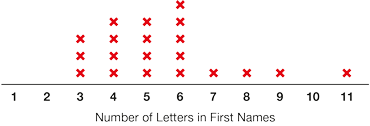L
length
The distance from end to end of an object.
pages 189–191, 199, 205, 227, 236, 291–292, 329–333, 510–511
less than
Not as many or as much as; e.g., 5 is less than (<) 8.
pages 70, 82–83, 96, 107–108, 376, 401, 405, 425, 470, 479, 494, 498, 540
line plot
A way of representing data on a number line that shows frequency of an event using a symbol, such as an X.

pages 42–43, 49–50
liter
Metric unit used to measure volume. A liter is a little more than a quart.
pages 107, 140, 331–332, 390–391, 400, 402, 416
lowest common denominator
The smallest number that can be divided exactly by all the denominators in a group of two or more fractions. For example, 12 is the lowest common denominator for 

pages 461–462
lowest common multiple
The smallest common multiple of two or more numbers. For example, the lowest common multiple of 3 and 5 is 15.
page 461
lowest terms
A fraction is in lowest terms if the numerator and denominator have no common factor greater than 1.
pages 211–215










